 W
WThe 17 July Revolution was a bloodless coup in Iraq in 1968 led by Ahmed Hassan al-Bakr, Abd ar-Razzaq an-Naif, and Abd ar-Rahman al-Dawud that ousted President Abdul Rahman Arif and Prime Minister Tahir Yahya and brought the Iraqi Regional Branch of the Arab Socialist Ba'ath Party to power. Ba'athists involved in the coup as well as the subsequent purge of the moderate faction led by Naif included Hardan al-Tikriti, Salih Mahdi Ammash, and Saddam Hussein, the future President of Iraq. The coup was primarily directed against Yahya, an outspoken Nasserist who exploited the political crisis created by the June 1967 Six-Day War to push Arif's moderate government to nationalize the British- and American-owned Iraq Petroleum Company (IPC) in order to use Iraq's "oil as a weapon in the battle against Israel." Full nationalization of the IPC did not occur until 1972, under the Ba'athist administration. In the aftermath of the coup, the new Iraqi government consolidated power by denouncing alleged American and Israeli machinations, publicly executing 14 people on fabricated espionage charges amidst a broader purge, and working to expand Iraq's traditionally close relations with the Soviet Union.
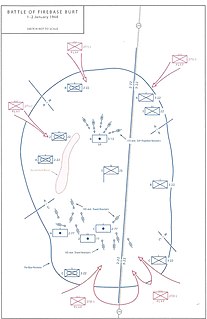 W
WThe New Year's Day battle of 1968 was a military engagement during the Vietnam War that began on the evening of 1 January 1968. It involved units assigned to the U.S. 25th Infantry Division and two regiments of the People's Army of Vietnam (PAVN).
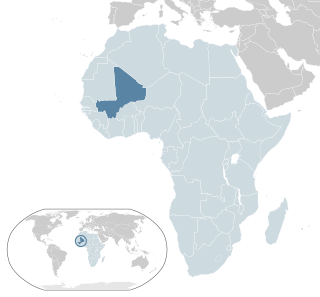 W
WThe 1968 Malian coup d'état was a bloodless military coup in Mali staged on 19 November 1968 against the government of President Modibo Keïta. The coup was led by Lieutenant Moussa Traoré, who then became the head of state.
 W
WThe 1968 Peruvian coup d'état took place during the Belaúnde administration (1963–1968), as a result of political disputes becoming norms, serious arguments between President Belaúnde and Congress rising, dominated by the APRA-UNO coalition, and even clashes between the President and his own Acción Popular party were common.[citation needed]. Congress went on to censor several cabinets of the Belaúnde administration, and a general political instability was perceived. General Juan Velasco Alvarado led the coup.
 W
WThe Abagana Ambush was an ambush by Biafran guerrilla troops led by Major Jonathan Uchendu that wiped out the Nigerian 2 Division. Of the 6,000 Nigerian troops ambushed, only a very small number survived, including the 2nd Division's commander, General Murtala Muhammad.
 W
WThe Action of 1 March 1968 refers to a co-ordinated attempt by four North Vietnamese trawlers to resupply the Viet Cong and the efforts of Operation Market Time elements to stop them during the Vietnam War. On 28 February 1968, United States Navy SP-2H Neptune aircraft on routine patrol detected a North Vietnamese SL class naval trawler heading towards the South Vietnamese coast from north of the DMZ. By the next morning, three more trawlers were discovered and units of Operation Market Time were deployed for a surprise interception. The suspect trawlers did not fly flags so it was not until the start of the engagement that their origin was discovered. The trawlers were steel-hulled vessels, 100 feet long and armed with 57-millimeter recoilless rifles and machine guns. All four vessels were loaded with weapons and ammunition intended to be delivered to the Viet Cong. American and South Vietnamese forces that engaged in action included the United States Coast Guard cutters Androscoggin, Point Grey, Point Welcome, Winona, Point Grace, Point Hudson, Point Marone, the swift boats USS PCF-18, USS PCF-20, USS PCF-42, USS PCF-43, USS PCF-46, USS PCF-47 and USS PCF-48, two South Vietnamese navy junks and one patrol boat. Two U.S. Army helicopter gunships also participated in combat as well as aircraft used to fire flares.
 W
WThe Angolan War of Independence, called in Angola the Luta Armada de Libertação Nacional, began as an uprising against forced cultivation of cotton, and it became a multi-faction struggle for the control of Portugal's overseas province of Angola among three nationalist movements and a separatist movement. The war ended when a leftist military coup in Lisbon in April 1974 overthrew Portugal's Estado Novo regime, and the new regime immediately stopped all military action in the African colonies, declaring its intention to grant them independence without delay.
 W
WThe Araguaia guerrilla was an armed movement in Brazil against its military dictatorship, active between 1967-1974 in the Araguaia river basin. It was founded by militants of the Communist Party of Brazil, the then Maoist counterpart to the Brazilian Communist Party (PCB), which aimed at establishing a rural stronghold from whence to wage a "people's war" against the Brazilian military dictatorship, which had been in power since the 1964 coup d'état. Its projected activities were based on the successful experiences led by the 26th of July Movement in the Cuban Revolution, and by the Communist Party of China during the Chinese Civil War.
 W
WThe Battle of Binh An was a battle during the Vietnam War that took place on 27-8 June 1968 in Quảng Trị Province when the US 3rd Squadron, 5th Cavalry Regiment and Troop D, 1st Squadron, 9th Cavalry Regiment defeated the People’s Army of Vietnam (PAVN) K14 Battalion, 812th Regiment.
 W
WThe Battle of Karameh was a 15-hour military engagement between the Israel Defense Forces (IDF) and combined forces of the Palestine Liberation Organization (PLO) and the Jordanian Armed Forces (JAF) in the Jordanian town of Karameh on 21 March 1968, during the War of Attrition. It was planned by Israel as one of two concurrent raids on PLO camps, one in Karameh and one in the distant village of Safi—codenamed Operation Inferno and Operation Asuta, respectively—but the former turned into a full-scale battle.
 W
WOperation Coburg was an Australian and New Zealand military action during the Vietnam War. The operation saw heavy fighting between the 1st Australian Task Force and North Vietnamese Army and Viet Cong during the wider fighting around Long Binh and Bien Hoa. American and South Vietnamese intelligence reports had indicated that an imminent communist offensive during the Tet New Year festival was likely, and in response the Australians and New Zealanders were deployed away from their base in Phuoc Tuy Province to bolster American and South Vietnamese forces defending the Long Binh–Bien Hoa complex north-east of Saigon. 1 ATF deliberately established fire support bases astride the communist lines of communication in the vicinity of the village of Trang Bom, expecting that they would attempt to destroy them. The Australians subsequently clashed with the Viet Cong during early patrols in Area of Operations (AO) Columbus, while later Fire Support Base (FSB) Andersen was repeatedly subjected to major ground assaults.
 W
WThe Communist insurgency in Malaysia, also known as the Second Malayan Emergency, was an armed conflict which occurred in Malaysia from 1968 to 1989, between the Malayan Communist Party (MCP) and Malaysian federal security forces.
 W
WThe Communist insurgency in Sarawak occurred in Malaysia from 1962 to 1990, and involved the North Kalimantan Communist Party and the Malaysian Government. It was one of the two Communist insurgencies to challenge the former British colony of Malaysia during the Cold War. As with the earlier Malayan Emergency (1948–1960), the Sarawak Communist insurgents were predominantly ethnic Chinese, who opposed to British rule over Sarawak and later opposed the merger of the state into the newly created Federation of Malaysia. The insurgency was triggered by the 1962 Brunei Revolt, which had been instigated by the left-wing Brunei People's Party in opposition to the proposed formation of Malaysia.
 W
WThe Battle of Coral–Balmoral was a series of actions fought during the Vietnam War between the 1st Australian Task Force and the North Vietnamese 7th Division and Viet Cong Main Force units, 40 kilometres (25 mi) north-east of Saigon. Following the defeat of the communist Tet offensive in January and February, in late April two Australian infantry battalions—the 1st and 3rd Battalions of the Royal Australian Regiment (RAR)—with supporting arms, were again deployed from their base at Nui Dat in Phước Tuy Province to positions astride infiltration routes leading to Saigon to interdict renewed movement against the capital. Part of the wider allied Operation Toan Thang I, it was launched in response to intelligence reports of another impending communist offensive, yet the Australians experienced little fighting during this period. Meanwhile, the Viet Cong successfully penetrated the capital on 5 May, plunging Saigon into chaos during the May Offensive in an attempt to influence the upcoming Paris peace talks scheduled to begin on the 13th. During three days of intense fighting the attacks were repelled by US and South Vietnamese forces, and although another attack was launched by the Viet Cong several days later, the offensive was again defeated with significant losses on both sides, causing extensive damage to Saigon and many civilian casualties. By 12 May the fighting was over, and the North Vietnamese and Viet Cong were forced to withdraw having suffered heavy casualties. US casualties were also heavy and it proved to be their most costly week of the war.
 W
WThe Battle of Dai Do took place from 30 April to 3 May 1968 in Quảng Trị Province during the Vietnam War.
 W
WDong Re Lao Mountain is located at 16.3038°N 107.2479°E in the A Shau Valley, Vietnam, near the Laotian border. It is densely forested and rises to 4,879 feet (1,487 m), just north of A Luoi, a former French airfield.
 W
WThe Guinea-Bissau War of Independence was an armed independence conflict that took place in Portuguese Guinea between 1963 and 1974. Fought between Portugal and the African Party for the Independence of Guinea and Cape Verde, an armed independence movement backed by Cuba and the Soviet Union, the war is commonly referred to as "Portugal's Vietnam" due to the large numbers of men and amounts of material expended in a long, mostly guerrilla war and the internal political turmoil it created in Portugal. The war ended when Portugal, after the Carnation Revolution of 1974, granted independence to Guinea-Bissau, followed by Cape Verde a year later.
 W
WThe Battle of Hat Dich was a series of military actions fought between an allied contingent, including the 1st Australian Task Force and the People's Army of Vietnam (PAVN) and Viet Cong (VC) during the Vietnam War. Under the codename Operation Goodwood, two battalions from 1 ATF deployed away from their base in Phuoc Tuy Province, operating against suspected PAVN/VC bases in the Hat Dich area, in western Phuoc Tuy, south-eastern Bien Hoa and south-western Long Khanh Provinces as part of a large allied sweep known as Operation Toan Thang II. The Australians and New Zealanders conducted sustained patrolling throughout the Hat Dich and extensively ambushed tracks and river systems in the Rung Sat Special Zone, occupying a series of fire support bases as operations expanded. Meanwhile, American, South Vietnamese and Thai forces also operated in direct support of the Australians as part of the division-sized action.
 W
WThe Battle of Huế, also called the Siege of Huế, was a major military engagement in the Tết Offensive launched by North Vietnam and the Việt Cộng during the Vietnam War. After initially losing control of most of Huế and its surroundings, the combined South Vietnamese and American forces gradually recaptured the city over one month of intense fighting. The battle was one of the longest and bloodiest of the war, and the battle negatively affected American public perception of the war.
 W
WIn the Vietnam War, after the assassinations of Ngo Dinh Diem and John F. Kennedy in late 1963 and the Gulf of Tonkin incident in 1964 and the continuing political instability in the South, the United States made a policy commitment to begin joint warfare in South Vietnam, a period of gradual escalation and Americanization, involving the commitment of large-scale combat forces from the United States and allied countries. It was no longer assumed the Republic of Vietnam could create a desirable situation without major external assistance. This phase of the war lasted until the election of Richard Nixon, and the change of U.S. policy to Vietnamization, or giving the main combat role back to the South Vietnamese military.
 W
WThe Battle of Kham Duc was a major battle of the Vietnam War. The event occurred in Khâm Đức, now district capital of Khâm Đức District, then in Quảng Tín Province, from 10–12 May 1968. During the Tet Offensive of 1968, the People's Army of Vietnam (PAVN) 2nd Division tried to capture Đà Nẵng, but they were defeated in the Battle of Lo Giang by elements of the U.S. 1st Marine Division and the 23rd Infantry Division (Americal). PAVN General Chu Huy Mân disengaged from the fight on the outskirts of the city, and pulled the 2nd Division into the mountains where it could rest, rebuild, and prepare for the next major operation. Khâm Đức, a small district in the north of Quảng Tín, was chosen as the next target for the 2nd Division. Following their defeat at Đà Nẵng, U.S. military intelligence agencies in I Corps Tactical Zone were confused by the movements of the 2nd Division, because they could not track down the unit.
 W
WThe Battle of Khe Sanh was conducted in the Khe Sanh area of northwestern Quảng Trị Province, Republic of Vietnam, during the Vietnam War. The main US forces defending Khe Sanh Combat Base (KSCB) were two regiments of the United States Marine Corps supported by elements from the United States Army and the United States Air Force (USAF), as well as a small number of Army of the Republic of Vietnam (ARVN) troops. These were pitted against two to three divisional-size elements of the North Vietnamese People's Army of Vietnam (PAVN).
 W
WThe Kilvenmani massacre was an incident in Kizhavenmani village, Tamil Nadu on 25 December 1968 in which a group of around 44 people, the families of striking village labourers, were murdered by a gang, allegedly led by their landlords.
 W
WThe Korean DMZ Conflict, also referred to as the Second Korean War by some, was a series of low-level armed clashes between North Korean forces and the forces of South Korea and the United States, largely occurring between 1966 and 1969 at the Korean DMZ.
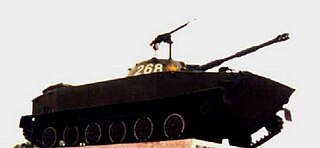 W
WThe Battle of Lang Vei began on the evening of 6 February 1968 and concluded during the early hours of 7 February, in Quảng Trị Province, South Vietnam. Towards the end of 1967 the 198th Tank Battalion, People's Army of Vietnam (PAVN) 202nd Armored Regiment, received instructions from the North Vietnamese Ministry of Defense to reinforce the 304th Division as part of the "Route 9-Khe Sanh Campaign". After an arduous journey down the Ho Chi Minh trail in January 1968, the 198th Tank Battalion linked up with the 304th Division for an offensive along Highway 9, which stretched from the Laotian border through to Quảng Trị Province. On 23 January, the 24th Regiment attacked the small Laotian outpost at Bane Houei Sane, under the control of the Royal Laos Army BV-33 "Elephant" Battalion.
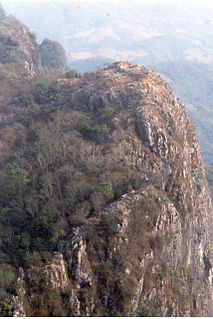 W
WThe Battle of Lima Site 85, also called Battle of Phou Pha Thi, was fought as part of a military campaign waged during the Vietnam War and Laotian Civil War by the North Vietnamese People's Army of Vietnam (PAVN) and the Pathet Lao, against airmen of the United States Air Force (USAF)'s 1st Combat Evaluation Group, elements of the Royal Lao Army, Royal Thai Border Patrol Police, and the Central Intelligence Agency-led Hmong Clandestine Army. The battle was fought on Phou Pha Thi mountain in Houaphanh Province, Laos, on 10 March 1968, and derives its name from the mountaintop where it was fought or from the designation of a 700 feet (210 m) landing strip in the valley below, and was the largest single ground combat loss of United States Air Force members during the Vietnam War.
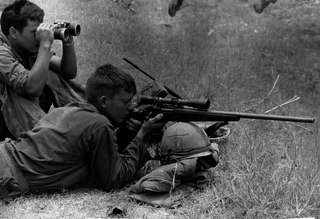 W
WOperation Mameluke Thrust was a US Marine Corps operation that took place in Happy Valley southwest of Danang, lasting from 19 May to 23 October 1968.
 W
WPHASE II of the Tet Offensive of 1968 was launched by the People's Army of Vietnam (PAVN) and Viet Cong (VC) against targets throughout South Vietnam, including Saigon from 29 April to 30 May 1968. The May Offensive was considered much bloodier than the initial phase of the Tet Offensive. US casualties across South Vietnam were 2,169 killed for the entire month of May making it the deadliest month of the entire Vietnam War for U.S. forces, while South Vietnamese losses were 2,054 killed. PAVN/VC losses exceeded 24,000 killed and over 2,000 captured. The May Offensive was a costly defeat for the PAVN/VC.
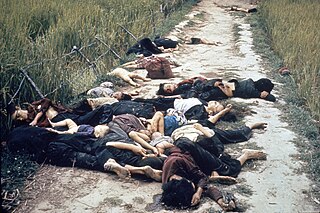 W
WThe Mỹ Lai massacre was the Vietnam War mass murder of unarmed South Vietnamese civilians by U.S. troops in Sơn Tịnh District, South Vietnam, on March 16, 1968. Between 347 and 504 unarmed people were killed by U.S. Army soldiers from Company C, 1st Battalion, 20th Infantry Regiment and Company B, 4th Battalion, 3rd Infantry Regiment, 11th Brigade, 23rd (Americal) Infantry Division. Victims included men, women, children, and infants. Some of the women were gang-raped and their bodies mutilated, as were children as young as 12. Twenty-six soldiers were charged with criminal offenses, but only Lieutenant William Calley Jr., a platoon leader in C Company, was convicted. Found guilty of killing 22 villagers, he was originally given a life sentence, but served only three-and-a-half years under house arrest.
 W
WOperation Niagara was a U.S. Seventh Air Force close air support campaign carried out from January through March 1968, during the Vietnam War. Its purpose was to serve as an aerial umbrella for the defense of the U.S. Marine Corps Khe Sanh Combat Base on the Khe Sanh Plateau, in western Quang Tri Province of the Republic of Vietnam. The base was under siege by an estimated three-divisional force of the People's Army of Vietnam (PAVN).
 W
WOn 23 January 1968 North Korean patrol boats supported by two Mikoyan-Gurevich MiG-21 fighters captured the USS Pueblo northeast of the North Korean island of Ung-do. The seizure of the Pueblo led to President Lyndon Johnson ordering a show of force with a massive deployment of U.S. air and navy assets to Korea. The airlift and deployment of 200+ aircraft was code named Operation Combat Fox while the deployment of six aircraft carriers plus support vessels was code named Operation Formation Star. The operations were supported by the partial mobilization of reservists for the first time since the Cuban Missile Crisis. CIA A-12 Oxcart reconnaissance overflights over North Korea were used to monitor a feared retaliatory mobilization of North Korean forces and when these flights revealed no mobilization or large scale deployments by North Korean forces, Operation Combat Fox forces were stood down.
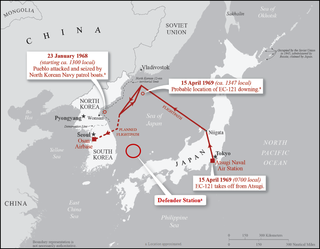 W
WOperation Formation Star was the code name for the emergency re-deployment of U.S. Seventh Fleet warships to the Sea of Japan off the eastern coast of North Korea following that country's seizure of the USS Pueblo (AGER-2) in international waters on 23 January 1968.
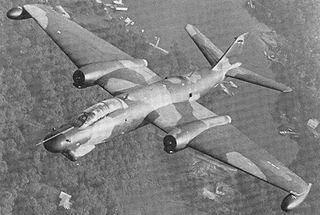 W
WOperation Shed Light was a crash development project in aerial warfare, initiated in 1966 by the United States Air Force to increase the ability to accurately strike at night or in adverse weather. During the 1960s the United States military worked hard to interdict the movement of men and materiel along the Ho Chi Minh trail. The North Vietnamese were experts in the use of weather and darkness to conceal their movement, and understanding the superiority of American air power put their skills immediately to good use. US forces seeking to impede the steady flow of supplies attempted to locate largely static targets during the day with poor results.
 W
WPark Chung-hee was a South Korean politician and Republic of Korea Army General who served as the President of South Korea from 1963 until his assassination in 1979, assuming that office after first ruling the country as head of a military dictatorship installed by the May 16 military coup d'état in 1961. Before his presidency, he was the chairman of the Supreme Council for National Reconstruction from 1961 to 1963 after a career as a military leader in the South Korean army.
 W
WThe protests of 1968 comprised a worldwide escalation of social conflicts, predominantly characterized by popular rebellions against the military and the bureaucracy.
 W
WUSS Pueblo (AGER-2) is a Banner-class environmental research ship, attached to Navy intelligence as a spy ship, which was attacked and captured by North Korean forces on 23 January 1968, in what is known today as the "Pueblo incident" or alternatively, as the "Pueblo crisis".
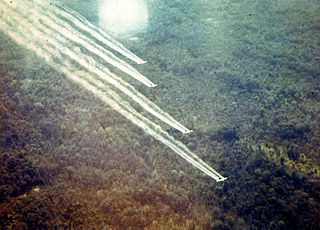 W
WOperation Ranch Hand was a U.S. military operation during the Vietnam War, lasting from 1962 until 1971. Largely inspired by the British use of 2,4,5-T and 2,4-D during the Malayan Emergency in the 1950s, it was part of the overall chemical warfare program during the war called "Operation Trail Dust". Ranch Hand involved spraying an estimated 20 million U.S. gallons (76,000 m3) of defoliants and herbicides over rural areas of South Vietnam in an attempt to deprive the Viet Cong of food and vegetation cover. Areas of Laos and Cambodia were also sprayed to a lesser extent. Nearly 20,000 sorties were flown between 1961 and 1971.
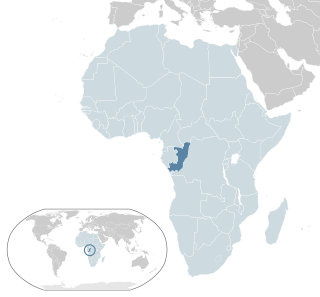 W
WOn September 4, 1968, following several days of violent clashes, Alphonse Massamba-Débat's government was overthrown by the military who forced Massamba-Débat to resign. Alfred Raoul then became the acting head of state until January 1969 when Marien Ngouabi, the chairman of the same party that had brought Massamba-Débat to power, assumed control.
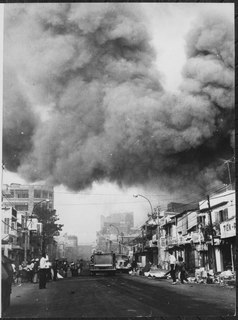 W
WThe First Battle of Saigon, fought during the Tet Offensive of the Vietnam War, was the coordinated attack by communist forces, including both the North Vietnamese Army and the Viet Cong (VC), against Saigon, the capital of South Vietnam.
 W
WThe Siege of Sanaa took place between November 1967 and February 1968, becoming a critical battle to determine the outcome of the North Yemen Civil War. With the eventual failure of the royalists to retake the city, Republicans won a de facto tactical victory in the war, retaining the seat of power, and gradually winning international recognition as a legitimate North Yemen government.
 W
WOperation Steel Tiger was a covert U.S. 2nd Air Division, later Seventh Air Force and U.S. Navy Task Force 77 aerial interdiction effort targeted against the infiltration of People's Army of Vietnam (PAVN) men and material moving south from the Democratic Republic of Vietnam through southeastern Laos to support their military effort in the Republic of Vietnam during the Vietnam War.
 W
WOperation Tiger Hound was a covert U.S. 2nd Air Division, later Seventh Air Force and U.S. Navy Task Force 77 aerial interdiction campaign conducted in southeastern Laos from 5 December 1965 till 11 November 1968, during the Vietnam War. The purpose of the operation was to interdict the flow of People's Army of Vietnam (PAVN) supplies on the Ho Chi Minh Trail from the Democratic Republic of Vietnam, through southeastern Laos, and into the northern provinces of the Republic of Vietnam. The missions were originally controlled by the 2d Air Division until that headquarters was superseded by the Seventh Air Force on 1 April 1966.
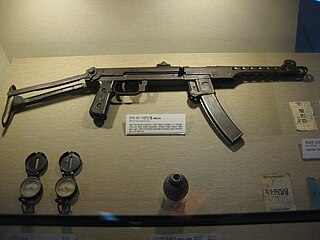 W
WThe Ulchin-Samcheok landings was an unsuccessful attempt by North Korea to establish guerrilla camps in the Taebaek Mountains on October 30, 1968, in order to topple Park Chung-hee's regime and bring about the reunification of Korea. As the DMZ became increasingly harder to penetrate after the Blue House Raid, Kim Il-sung deployed 120 North Korean commandos along eight separate coastal locations between Ulchin and Samcheok in Gangwon province on an important mission to indoctrinate South Korean citizens, which ended in failure.
 W
WThe year 1968 saw major developments in the Vietnam War. The military operations started with an attack on a US base by the North Vietnamese People's Army of Vietnam (PAVN) and the Viet Cong (VC) on January 1, ending a truce declared by the Pope and agreed upon by all sides. At the end of January, the PAVN and VC launched the Tet Offensive.
 W
WThe War of Attrition involved fighting between Israel and Egypt, Jordan, PLO and their allies from 1967 to 1970.
 W
WThe Warsaw Pact invasion of Czechoslovakia, officially known as Operation Danube, was a joint invasion of Czechoslovakia by five Warsaw Pact countries – the Soviet Union, Poland, Bulgaria, East Germany and Hungary – on the night of 20–21 August 1968. Approximately 250,000 Warsaw Pact troops attacked Czechoslovakia that night, with Romania and Albania refusing to participate. East German forces, except for a small number of specialists, did not participate in the invasion because they were ordered from Moscow not to cross the Czechoslovak border just hours before the invasion. 137 Czechoslovakian civilians were killed and 500 seriously wounded during the occupation.